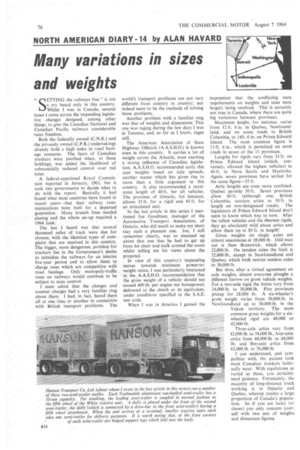Many variations in sizes and weights
Page 78

If you've noticed an error in this article please click here to report it so we can fix it.
S " ETTING the railways free" is not a cry heard only in this country.
Whilst I was in Canada, several times I came across the impending legislative changes designed, among other things, to give the Canadian National and Canadian Pacific railways considerable rates freedom.
Both the federally owned (C.N.R.) and the privately owned (C.P.R.) undertakings already hold a high stake in road haulage concerns. The fears of Canadian truckers were justified when, to these holdings, was added the likelihood of substantially reduced control over rail rates.
A federal-appointed Royal Commission reported in January, 1962, but it took two governments to decide what to do with the report. Basically it had found what most countries have found in recent years—that their railway communications were built for a departed generation. Many branch lines neededclosing and the whole set-up required a
1964 look. • The last I heard was that several thousand miles of track were due for closure, with the identical types of corn-. plaint that are received in this country. The bigger, more dangerous, problem for truckers lies in the Government's desire to subsidize the railways for an interim five-year period and to allow them to charge rates which are competitive with road haulage. Only monopoly-traffic rates on railways would continue to be subject to state control.
I must admit that the charges and counter charges had a very familiar ring about them. I had, in fact, heard them all at one time or another in connection with British transport problems. The world's transport problems are not very different from country to country; nor indeed seem to be the methods of solving those problems.
Another problem with a familiar ring was that of weights and dimensions: This one was raging during the few days I was in Toronto, and, so far as I know, rages still.
The American Association of State Highway Officials (A.A.S.H.O.) is known even in this country. It carries a lot of weight across the Atlantic, even exerting a strong influence of Canadian legislation. A.A.S.H.O. recommended early this year weights based on axle spreads, another matter which has given rise to more than a little argument in this country. It also recommended a maximum length of 40 ft. for all vehicles. The province of Ontario, for instance, allows, 35 ft. for a rigid and 45 ft. for an articulated unit.
In the last article in this series I mentioned Joe Goodman, manager of the Automotive Transport Association, of Ontario, who did much to make my short stay such a pleasant one. Joe, I still remember clearly, was so steamed up about that one that he had to get up from his chair and stalk around the room whilst telling me his views about the proposal.
In view of this country's impending moves towards minimum power-toweight ratios. I was particularly interested in the A.A.S.H.O. recommendation that the gross weight of a vehicle should not exceed 400 lb. per engine net horsepower, delivered to the clutch or its equivalent, under conditions specified in the S.A.E. test code.
When I was in America I gained the
impression that the conflicting state requirements on weights and sizes were largely being resolved. This is certainly not true in Canada, where there are quite big variations between provinces.
Maximum height, for instance, varies from 12 ft. 6 in. in Quebec, Newfoundland, and on some roads in British Columbia, to 14ft. 6 in. on Prince Edward Island. The most common figure is 13 ft. 6 in., which is permitted on most roads in seven of the 11 province& Lengths for rigids vary from 33 ft. on Prince Edward Island (which, conversely, allowed the highest vehicles) to 40 ft. in Nova Scotia and Manitoba. Again, seven provinces have settled for the same figure-35 ft.
Artic lengths are even more confused. Quebec permits 50 ft. Seven provinces allow 60 ft. (although one, British Columbia, restricts artics to 50 ft. in length on non-designated roads). The legislators of Prince Edward Island don't seenn to know which way to turn. After the tallest vehicles and the shortest rigids, they go absolutely wild about artics and allow them up to 85 ft. in length!
Gross weights on single axles are almost unanimous at 18,000 lb. Odd man out is New Brunswick, which allows 22,000 lb. On tandem axles the limit is 32,000 lb., except in Newfoundland and Quebec, which both restrict tandem axles to 30,000 lb.
But then, after a virtual agreement on axle weights, almost everyone ploughs a different furrow on gross vehicle weights. For a two-axle rigid the limits vary from 24,000 lb. to 30,000 lb. Five provinces plump for 28,000 lb. A six-wheeler's gross weight varies from 30,000 lb. in Newfoundland up to 50,000 lb. in the Yukon territory. The most common gross weights for a sixwheeled rigid are 40,000 or 42,000 lb.
Three-axle artics vary from 42,000 lb. to 54,000 lb., four-axle artics from 48,000 lb. to 68,000 lb. and five-axle artics from 62,000 lb. to 76,000 lb.
I can understand, and sympathize with, the patient look most Canadian truckers habitually wear. With regulations as varied as these, you certainly need patience. Fortunately, the majority of long-distance truck working is in Ontario and Quebec, wherein resides a large proportion of Canada's population. So if you are lucky (or clever) you only concern yourself with two sets of weights and dimension figures.
























































































































